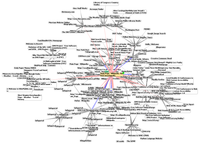
Photo from wikipedia
Statistical methods are useful tools to aid the recognition of patterns and extract information from a large amount of data available through resources such as earthquake catalogs. Visibility graph analysis… Click to show full abstract
Statistical methods are useful tools to aid the recognition of patterns and extract information from a large amount of data available through resources such as earthquake catalogs. Visibility graph analysis is one of these relatively new statistical techniques that can be applied on data in the form of time series, and map them into a graph of nodes and connections, which makes it possible to use network theory for characterizing the original data. We present a study applying visibility graph analysis to a seismicity catalog for the Alaska crust and the Aleutian subduction zone. The catalog is gathered from the United States Geological Survey database, for the years between 1900 and mid 2017. A history of several earthquakes and a variety in seismic features, both near surface and at depth, make this region one of the richest areas to investigate possible seismic patterns and correlations. The focus here is on examining the previously suggested correlation between b value of the Gutenberg–Richter relation and the k–M slope from a visibility graph analysis. The visibility graph method defines a k degree or connectivity degree for each event according to its magnitude and position in time series. The k–M slope represents the slope of the regression line of these pairs of magnitude and connectivity degree, as a single number for each zone. We calculate the k–M slope for selected zones for Alaska and the Aleutians and add it to the data from previous worldwide studies and the results verify and improve the linear universal relationship between b value and k–M slope suggested by past studies, which indicates that the visibility graph analysis can work as an alternative approach for studying earthquake sequence.
Journal Title: Pure and Applied Geophysics
Year Published: 2018
Link to full text (if available)
Share on Social Media: Sign Up to like & get
recommendations!